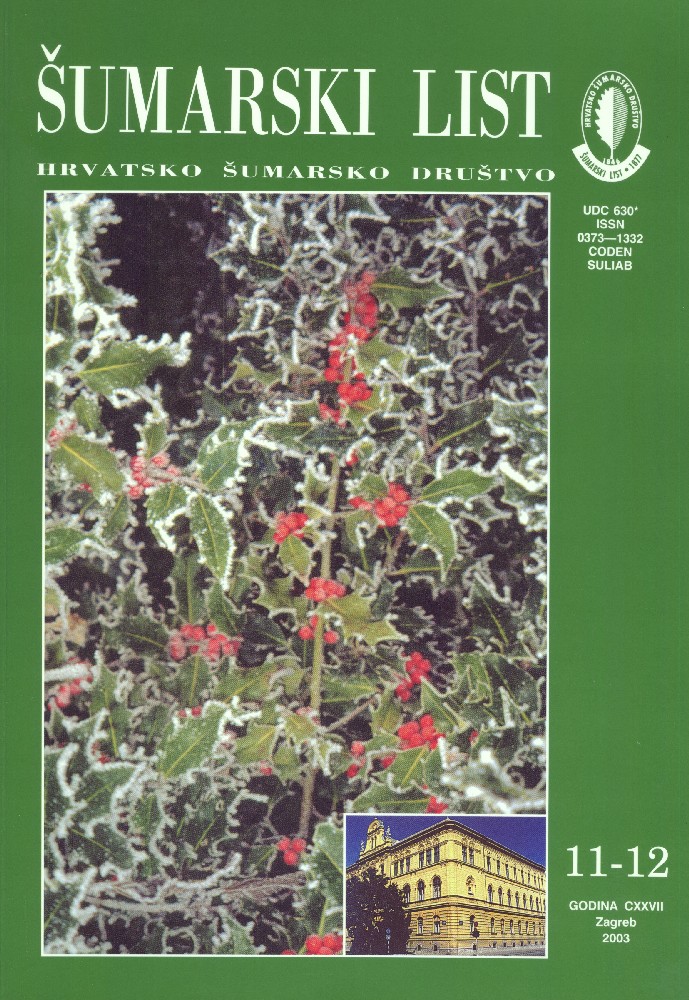
broj: 11-12/2003
pdf (31,0 MB) |
|
||||||||||||||
| IZVORNI ZNANSTVENI ČLANCI | ||
| Vukelić, J., Baričević, D., Drvenkar, D. | UDK 630* 188 (001) | |
| Phytocoenological Characteristics of Beech Forests in Samoborsko Gorje pdf HR EN | 531 | |
| Idžojtić, M., Pernar, R., Kauzlarić, Ž., Abramović, M., Janković, D., Pleše, M. | UDK 630* 442 + 582 (001) | |
| Intensity of Infestation of Silver Fir (Abies alba Mill.) with Mistletoe (Viscum album L. ssp. abietis (Wiesb.) Abrom.) in the Area of the Forest Administration of Delnice pdf HR EN | 545 | |
| Starčević, M. | UDK 630* 423 + 181.3 + 188 (001) | |
| The Effect of Precipitation, Flood and Groundwater on the development of Stands in the Forest Complex “Česma” pdf HR EN | 561 | |
| Summary: Water, whether in the form of groundwater, floodwater or precipitation, is the most important ecological factor which has a decisive role in the survival and development of forests of pedunculate oak. Changes in moisturising intensity of any of these waters cause changes in the conditions to which these forests have adapted over thousands of years. These changes always have an adverse impact on their stability, productivity and the possibility of natural regeneration. Man with his powerful influence on the plant cover frequently interrupts or changes the natural plant growth, disturbs natural conditions and causes significant changes in the plant cover. The impact of man on these forests is very important in terms of their quality and survival. Intensive interventions in the water regime within or in the vicinity of these forests have changed ecological conditions, which has led to dieback, an altered stand structure and aggravated regeneration. The area of the management unit "Česma" is one of the typical sites of pedunculate oak in Croatia, where dieback of pedunculate oak has taken root. The regulation of the river Česma has changed its natural flow considerably and has created long and straight beds, while the old meandering flow has remained in the forest and in clearings as a meander retaining water. Using all available documentation for the management unit "Česma" (management plans, phytocoenological maps, flood maps, data on dead trees, data on hydro-technical operations), data on climate from the meteorological station Čazma, as well as all works published by the scientists from the Faculty of Forestry and Forestry Institute in Jastrebarsko, the impact of precipitation, flood and groundwater on the development of stands in the forest complex "Česma" has been studied. Key words: precipitation; flood; groundwater; piezometer; phytocoenological record; community of pedunculate oak; management unit "Česma"; present conditions of forests; past condition; changes; stand structure; ecological indicators; multi-dimensional scaling; forest dieback | ||
| STRUČNI ČLANCI | ||
| Tomašević, A., Kulić, B., Španjol, Ž., Kružić, T. | UDK 630* 232.4 + 234 + 524 | |
| Development of Black Pine Stands (Pinus Nigra Arn.) and their Ameliorating Role in the Forest District of "Lonja-Biljin", Forest Office Rijeka pdf HR EN | 579 | |
| Božičević, I., Radočaj, M. | UDK 630* 902 | |
| Forestry in the Region of Slunj pdf HR EN | 597 | |
| Domac, J. | UDK 630* 931 + 238 | |
| Energy Sector Legal Framework for the Forest Biomass and the Renewable Energy Utilisation in the European Union and the Republic of Croatia pdf HR EN | 609 | |


